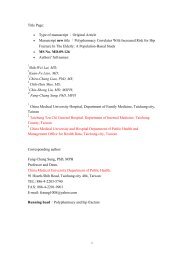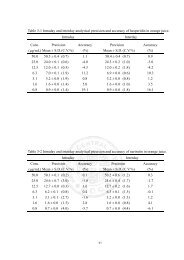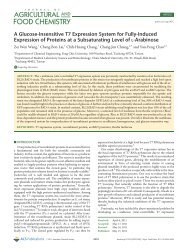Culinary Narratology in Everyday Life: Foodways and Identity ...
Culinary Narratology in Everyday Life: Foodways and Identity ...
Culinary Narratology in Everyday Life: Foodways and Identity ...
Create successful ePaper yourself
Turn your PDF publications into a flip-book with our unique Google optimized e-Paper software.
<strong>Cul<strong>in</strong>ary</strong> <strong>Narratology</strong> 8<br />
<strong>in</strong> which an <strong>in</strong>dividual longs for an idealized or purified version of an imag<strong>in</strong>ary homel<strong>and</strong> or<br />
an earlier time period. This yearn<strong>in</strong>g may <strong>in</strong>stigate these diasporic women’s attempts to<br />
recreate an aspect of their past lives by replicat<strong>in</strong>g the smells <strong>and</strong> the tastes of the past.<br />
Lahiri’s collection of short stories, Interpreter of Maladies, sheds light on South Asian<br />
immigrants’ sense of alienation <strong>and</strong> isolation <strong>in</strong> adapt<strong>in</strong>g to American society. Of these<br />
stories, “Mrs. Sen’s” represents South Asian female immigrants <strong>in</strong> their early years of<br />
struggl<strong>in</strong>g to survive <strong>in</strong> geographic displacement. In a way, “Mrs. Sen’s” speaks for most<br />
isolated women immigrants of Indian descent, as well as other orig<strong>in</strong>s, through its portrayal<br />
of the poignant ambivalence of female immigrants <strong>in</strong>tend<strong>in</strong>g to adapt to a new culture, but<br />
simultaneously feel<strong>in</strong>g a strong attachment to most aspects of their previous lifestyle, which,<br />
however, are considered <strong>in</strong>appropriate <strong>in</strong> their new environment. In this story, Mrs. Sen, the<br />
wife of an Indian professor who teaches mathematics at an American college, is portrayed as<br />
a desperate first generation Bengali immigrant woman who ghettoizes herself <strong>in</strong> nostalgia for<br />
her Indian life. She babysits Eliot, a young boy from a broken American family, <strong>and</strong><br />
Lahiri’s narrative pays great attention to Mrs. Sen’s meticulous preparation of food, quite<br />
unlike Eliot’s mother, a career woman. 3 Based on Eliot’s observations, readers learn that<br />
there are only two th<strong>in</strong>gs that can make Mrs. Sen happy, which are letters from her family <strong>in</strong><br />
India, <strong>and</strong> Indian cuis<strong>in</strong>e, which rem<strong>in</strong>ds her of home <strong>in</strong> India. In the detailed descriptions<br />
of everyday foodways <strong>and</strong> food-related behaviors that appear <strong>in</strong> the story, fresh fish, which is<br />
difficult to buy <strong>in</strong> the downtown supermarkets, is shown as be<strong>in</strong>g very crucial <strong>in</strong> her cookery:<br />
“It was always a whole fish she desired, not shellfish, or the fillets that Eliot’s mother had<br />
broiled” (123). In order to get fresh fish, Mrs. Sen has to rely on her <strong>in</strong>creas<strong>in</strong>gly reluctant<br />
husb<strong>and</strong> to drive her to her to a specific store. One day, she overcomes her fear of driv<strong>in</strong>g,<br />
tak<strong>in</strong>g Eliot along with her to the store. Unfortunately, she has an accident, <strong>and</strong> although<br />
Eliot <strong>and</strong> Mrs. Sen are not seriously <strong>in</strong>jured, she is not able to babysit the boy anymore, <strong>and</strong><br />
the narrative ends.









